| dc.contributor.advisor | Anthes, Emily | |
| dc.contributor.author | Evergreen, Shel | |
| dc.date.accessioned | 2023-01-20T15:30:52Z | |
| dc.date.available | 2023-01-20T15:30:52Z | |
| dc.date.issued | 2022-09 | |
| dc.date.submitted | 2022-08-29T15:17:50.889Z | |
| dc.identifier.uri | https://hdl.handle.net/1721.1/147595 | |
| dc.description.abstract | Thousands of rare diseases affect 300 million people globally, but a potential breakthrough in one sheds light on the systemic barriers to research and diagnosis.
Ehlers-Danlos Syndrome (EDS) has thirteen subtypes, and, to date, all but one have at least one identified genetic marker. In 2021, researchers at the Medical University of South Carolina announced they may have found the first genetic marker for Hypermobile Ehlers-Danlos Syndrome (hEDS). This subtype is the most common and is commonly believed to be less severe than other types of EDS, which is not the case. Further, recent research shows hEDS may not be rare at all, a misconception that is potentially a consequence of systemic underdiagnosis that impacts both patient lives and the flow of research funding.
Through stories of scientific research, healthcare provers, and patient experiences, this thesis illustrates the interplay between: difficulty of rare disease diagnosis, systemic barriers that prevent diagnosis, and the effects these have on institutional research into rare disease. | |
| dc.publisher | Massachusetts Institute of Technology | |
| dc.rights | In Copyright - Educational Use Permitted | |
| dc.rights | Copyright retained by author(s) | |
| dc.rights.uri | https://rightsstatements.org/page/InC-EDU/1.0/ | |
| dc.title | Think ‘Zebra’ | |
| dc.type | Thesis | |
| dc.description.degree | S.M. | |
| dc.contributor.department | Massachusetts Institute of Technology. Program in Comparative Media Studies/Writing | |
| dc.contributor.department | Massachusetts Institute of Technology. Graduate Program in Science Writing | |
| mit.thesis.degree | Master | |
| thesis.degree.name | Master of Science in Science Writing | |
